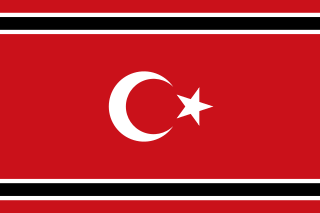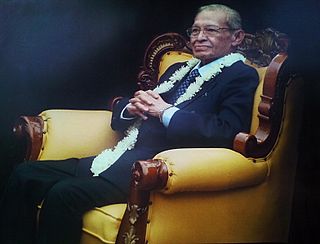
Aceh, officially the Aceh Province is the westernmost province of Indonesia. It is located on the northernmost of Sumatra island, with Banda Aceh being its capital and largest city. Granted a special autonomous status, Aceh is a religiously conservative territory and the only Indonesian province practicing the Sharia law officially. There are ten indigenous ethnic groups in this region, the largest being the Acehnese people, accounting for approximately 80% to 90% of the region's population.

The Free Aceh Movement was a separatist group seeking independence for the Aceh region of Sumatra, Indonesia. GAM fought against Indonesian government forces in the Aceh insurgency from 1976 to 2005, during which over 15,000 lives are believed to have been lost.

PT Pertamina (Persero), formerly abbreviated from Perusahaan Pertambangan Minyak dan Gas Bumi Negara (lit. 'State Oil and Natural Gas Mining Company'), is an Indonesian state-owned oil and natural gas corporation based in Jakarta. It was created in August 1968 by the merger of Pertamin (established 1961) and Permina (established 1957). In 2020, the firm was the third-largest crude oil producer in Indonesia behind US-based companies ExxonMobil's Mobil Cepu Ltd and Chevron Pacific Indonesia. In 2013, Pertamina was included for the first time in the Fortune Global 500 list of companies, ranked at 122 with revenues of $70.9 billion, it was also the sole Indonesian company to be featured in the list. According to the 2020 Fortune list, Pertamina is the largest company in Indonesia.

Hasan Muhammad di Tiro, M.S, M.A, LL.D, Ph.D., born Hasan Bin Leube Muhammad, was the founder of the Free Aceh Movement (GAM), an organisation which attempted to separate Aceh from Indonesia from the 1970s. It surrendered its separatist goals and agreed to disarm as agreed to in the Helsinki peace deal of 2005. He was the maternal great-grandson of Tengku Cik di Tiro, an Indonesian national hero who was killed fighting the Dutch in 1891. In 2010 he obtained his Indonesian citizenship back shortly before his death.

Lhokseumawe, is the second largest city in Aceh province, Indonesia. The city covers an area of 181.06 square kilometres, and had a population of 171,163 at the 2010 census and 188,713 at the 2020 census; the official estimate as at mid 2021 was 189,941. The city is a key regional centre important for the economy of Aceh.
The South Pars/North Dome field is a natural-gas condensate field located in the Persian Gulf. It is by far the world's largest natural gas field, with ownership of the field shared between Iran and Qatar. According to the International Energy Agency (IEA), the field holds an estimated 1,800 trillion cubic feet of in-situ natural gas and some 50 billion barrels of natural gas condensates. On the list of natural gas fields it has almost as much recoverable reserves as all the other fields combined. It has significant geostrategic influence.

North Aceh Regency is a regency in Nanggroe Aceh Darussalam, in Indonesia. It is located on the island of Sumatra. The regency covers an area of 3,236.86 square kilometres and had a population of 534,085 at the 2010 census and 602,793 at the 2020 Census; the official estimate as at mid 2021 was 608,106. The administrative centre is now at Lhoksukon; this followed the separation in 2001 of the former capital of Lhokseumawe, which was cut out of the regency by Law No. 2 of 2001 on 21 June 2001 to form an independent city.

Qatargas is the world's largest liquefied natural gas (LNG) company. It produces and supplies the globe with 77 million metric tonnes of LNG annually from across its seven ventures—Qatargas 1, Qatargas 2, Qatargas 3, Qatargas 4, RL1, RL2 and RL3. It is headquartered in Doha, Qatar, and maintains its upstream assets in Ras Laffan, Qatar. Natural gas is supplied to Qatargas's LNG trains from Qatar's North Field, by far the world's largest non-associated gas field. It reached a record LNG production of 77 million tonnes per year in December 2010.
Angola LNG is a liquid natural gas (LNG) facility in Soyo, Angola.
The Zelten oil field is located at the foot of the Zelten Mountains, about 169 kilometres (105 mi) south of Brega in Concession 6. Zelten holds the title as the largest oil field in the Gulf of Sidra. The 229 wells in Zelten use a gas lifting system. The Zelten oil field is not associated with the town Zelten, which is located in the North-West of Libya.
Human rights violations in Aceh, Indonesia occurred in the late 1990s and early 2000s when ExxonMobil hired Indonesian military units to guard their Arun gas field, and these military units raided and razed local villages. Government inquiries have extensively documented these abuses. Victims allege that ExxonMobil knew about the atrocities, which include assault, torture, and murder, and should be liable for them. The company denies these accusations; its primary defense is that the human rights violations which were occurring were not a result of specific intention of the organization and therefore it cannot be held liable.

The insurgency in Aceh, officially designated the Rebellion in Aceh by the Indonesian government, was a conflict fought by the Free Aceh Movement (GAM) between 1976 and 2005, with the goal of making the province of Aceh independent from Indonesia. The aftermath of a strong military offensive in 2003 and the 2004 Indian Ocean earthquake brought a peace agreement and an end to the insurgency.

The State of Alaska is both a producer and consumer of natural gas. In 2006, Alaska consumed 180.4 Bcf of natural gas.

The natural gas in Qatar covers a large portion of the world supply of natural gas. According to the Oil & Gas Journal, as of January 1, 2011, reserves of natural gas in Qatar were measured at approximately 896 trillion cubic feet ; this measurement means that the state contains 14% of all known natural-gas reserves, as the world's third-largest reserves, behind Russia and Iran. The majority of Qatar's natural gas is located in the massive offshore North Field, which spans an area roughly equivalent to Qatar itself. A part of the world's largest non-associated, natural-gas field, the North Field, is a geological extension of Iran's South Pars / North Dome Gas-Condensate field, which holds an additional 450 trillion cubic feet of recoverable natural-gas reserves.

In 2019, the total energy production in Indonesia is 450.79 Mtoe, with a total primary energy supply is 231.14 Mtoe and electricity final consumption is 263.32 TWh. Energy use in Indonesia has been long dominated by fossil resources. Once a major oil exporter in the world and joined OPEC in 1962, the country has since become a net oil importer despite still joined OPEC until 2016, making it the only net oil importer member in the organization. Indonesia is also the fourth-largest biggest coal producer and one of the biggest coal exporter in the world, with 24,910 million tons of proven coal reserves as of 2016, making it the 11th country with the most coal reserves in the world. In addition, Indonesia has abundant renewable energy potential, reaching almost 417,8 gigawatt (GW) which consisted of solar, wind, hydro, geothermal energy, ocean current, and bioenergy, although only 2,5% have been utilized. Furthermore, Indonesia along with Malaysia, have two-thirds of ASEAN's gas reserves with total annual gas production of more than 200 billion cubic meters in 2016.
A floating liquefied natural gas (FLNG) facility, is a floating production storage and offloading unit that conducts liquefied natural gas (LNG) operations for developing offshore natural gas resources. Floating above an offshore natural gas field, the FLNG facility produces, liquefied stores and transfers LNG at sea before carriers ship it directly to markets.
John Doe VII v. Exxon Mobil Corp (09–7125) is a lawsuit filed in the United States by 11 Indonesian villagers against ExxonMobil Corporation alleging that the company is responsible for human rights violations in the oil-rich province of Aceh, Indonesia. The case has broad implications for multinational corporations doing business in other countries. Indonesian security forces committed torture, rape, and murder against the plaintiffs and their families while under contract with ExxonMobil to guard the Arun gas field during the late 1990s and early 2000s; plaintiffs claim that Exxon is responsible for these atrocities.
The Hides gas field is a natural gas field located in the Hela Province of Papua New Guinea. It was discovered by BP in 1987 who relinquished their interest, and later developed by ExxonMobil. It began production in 1988 and produces natural gas and condensates. The total proven reserves of the Hides gas field are around 7.1 trillion cubic feet (203×109m³), and production is slated to be around 100 million cubic feet/day (2.9×106m³) in 2010.
The Port of Krueng Geukueh, sometimes called the Port of Lhokseumawe, is a seaport in Aceh, Indonesia, located on the Strait of Malacca.

Badak LNG, or formerly known as PT Badak Natural Gas Liquefaction or PT Badak NGL, is the largest liquefied natural gas (LNG) company in Indonesia and one of large LNG plants in the world. The company is located in Bontang, East Kalimantan, and has 8 process train capable of producing 22.5 Million Metric Tonnes Per Annum (MTPA) of LNG. Badak LNG is one of the big contributors to GDP for both Bontang and Indonesia in petroleum and gas sector. Badak LNG is also one of LNG plants in Indonesia besides Arun LNG, Donggi Senoro LNG, and Tangguh LNG.












